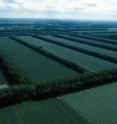Assessing agroforestry's advantages
Agroforestry, the deliberate placement of trees into crop and livestock operations, can help capture substantial amounts of carbon on agricultural lands while providing production and conservation benefits. However, we currently lack tools for accurately estimating current and projected carbon values in these systems. In North America, windbreaks are an effective carbon-capturing option. Only occupying about 2 to 5% of the land, windbreaks also help protect crops and livestock, as well as reduce wind erosion. They provide a means to increase production while reducing greenhouse gases.
James Brandle, a University of Nebraska–Lincoln professor, explains that unlike forests, the linear design of windbreaks creates a more open environment with different light and climate conditions. As a result, agroforestry trees usually have different characteristics than trees grown under forest conditions. New tools specifically designed for windbreak trees are needed to determine current or future amounts of carbon contained in agroforestry practices.
Researchers at the University of Florida, University of Kansas, University of Nebraska and the USDA National Agroforestry Center (NAC) have developed a model to predict the amount of carbon contained by agroforestry systems. This modeling approach uses detailed web-available data for windbreak, soils and climate.
While this research focused only on green ash windbreak growth in Nebraska, it provides a good basis for determining agroforestry's contributions in farming operations.
Source: American Society of Agronomy
Other sources
- Assessing agroforestry's advantagesfrom Physorg13 years ago
- Assessing Agroforestry's Advantagesfrom Newswise - Scinews13 years ago
- Analyzing agroforestry managementfrom Science Daily13 years ago
- Analyzing agroforestry managementfrom Physorg13 years ago


